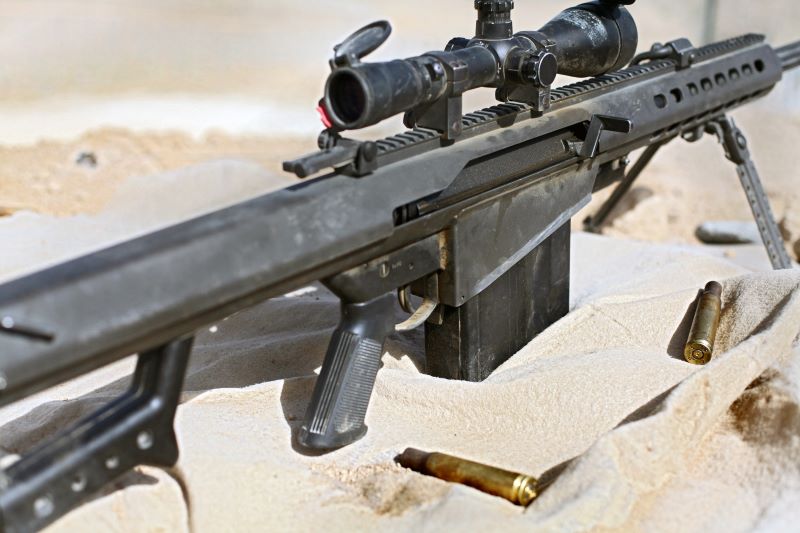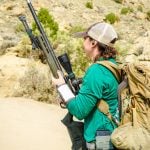In short, a brand new M107 shot a 1MOA group with touching rounds. So…yes it can. Even with standard ball ammo? Also yes.
The information in this article is going to come from years of experience working full time in the Army National Guard (the state will not be named) supporting sniper sections that employ the M107 .50 caliber Sniper Rifle. This article will only focus on the issued M107, the issued ammunition M33 standard ball, and Army turn-in procedures.

Before going too deep into this let’s go over some small background information, you know, the acronym definitions and such.
Within the Army National Guard (ARNG) there are Field Maintenance Shops (FMS). These shops employ a full-time force that supports the state as a whole. This full-time force, dependent on the job, is usually Technicians that are NG Soldiers who support their battalion on the weekend and the state during the week. Sometimes contractors do that job.
All firearms that need annual gauging and servicing, including any repairs and code outs, come to the FMS for service and repair. The code outs are an important thing to remember here. Any weapon that is deemed irreparable will be coded out and sent back to depot-level maintenance for a refurbish. This code out MUST be done by a Small Arms Technician at the FMS. A soldier/operator cannot deem the weapon irreparable as they are not trained or of the higher echelon that maintenance at the FMS is. The FMS also knows the Tank Automotive Command (TACOM) standards as to when a gun can be refurbished. This means that the gun has to reach certain criteria before it can go back to depot level. This is basically to ensure that we don’t put guns out of service without it being necessary to just get a new gun. Usually, the unit does a one-for-one swap so it won’t be down an M107. Once their old M107 is turned in, they will have a new one already on the books.
Noticing A Problem
The M107 started being issued in this state in the ’90s, and since then, not one sniper rifle has been refurbished, it is now 2020.
We have seen normal wear and tear on the guns, such as weak/worn extractors, broken ejectors, etc. With this, the operator would write the problem up and send it to the FMS. From there, the FMS would rebuild the bolt and send the gun back to the unit. Case closed right? Not really.
There were more problems that weren’t being addressed. Units would write up the issues with the bolts but they also wrote up that grouping was poor, very poor. The FMS wouldn’t take this seriously and just chalk it up to copper fouling and that the sniper section should “clean their barrels better”, and “take care of their guns more”.
When it comes to a sniper section talking to maintenance folk, there can be a disconnect. One doesn’t feel like the other knows what precision is or even how to shoot—so how can they tell a section that the grouping is due to a dirty gun? The other side feels as though that section may lack care for their rifle or even respect for the maintenance folk. This kind of disconnect is a standard when it comes to two groups working together on one problem, especially in the military.
So how do we work through that? Both groups can go out to the range with every M107 in the section and do a simple grouping exercise.
Grouping Exercise
Before doing the grouping exercise a few things need to happen. First, each round count needs to be noted on each gun. This is to show if the gun is within the TACOM code out standards and to have a baseline when looking at the performance of the section’s other guns. Then, we go over maintenance. Did the unit properly rid the barrel of copper fouling? Is the muzzle brake clear of fouling? We do this because we know that this is exactly what the FMS is going to ask first. Now, use ammo from the same lot. Take out every variable that you can.
From here, group each gun. This sniper section put up a large board with three different center circles on it and grouped from 100m, to really show the grouping size of each gun next to each other. Here are those groups. Mind you, gun three is the gun that has been sent back for multiple bolt fixes and failures to group.


M107 TACOM Turn-In Requirements
- 3.7.2 Rifle requirements.
- 3.7.2.1 Barrel life. The barrel life of the rifle shall be not less than 1000 rounds (T), 3,000 rounds (O).
- A barrel shall be considered unserviceable when the dispersion measured is greater than 3.75 inches at 328.08 feet (100 meters).
Gun 3 was well over the serviceable grouping dispersion requirement.
Fixing the Problem
So now we have proof that in fact, gun three is shot out. To go about turning it in, after everything is documented, the gun will have to go back to the FMS to code out. Once that gun is coded out, your property book officer (PBO) will send it back to depot-level maintenance for a refurbish and the unit will do a one-for-one swap. The old M107 goes to depot, and a new M107 is added to the property book.

Proof
In this specific scenario, after showing this information to the Field Maintenance Shop, Gun 3 was turned in. I was then informed that after the 1-for-1 swap, the new M107 shot a 4-round 1 MOA group with touching holes at 100m.
That just goes to show that the capabilities of the M107 are there, with a non-shot-out barrel.
Stay Prepared
The work starts when the sniper section first receives the gun.
- Accurate round counts must be taken
- Proper cleanliness must be done
- Document data on a 2404 with specifics such as round count and grouping size.
- When sending back a sniper rifle to the FMS, at least take the cleaning equipment out of the packaging. It’ll give off the notion that you are cleaning the gun.
Working with your FMS first is huge. Create the relationship. See what they think are the proper cleaning procedures. Ask them about the proper turn-in criteria and processes.
When the gun goes in for a bolt rebuild it is important to note where the gun is at, as far as barrel life. If your gun is stove piping it has probably gone through a fairly large amount of rounds, so a bolt rebuild could be an indicator that it is getting close to time.
Fun Fact: Sending the gun back to depot-level maintenance is important in itself because sometimes manufacturers put out system updates. If the updates are approved by the Army, the gun going in for a refurb could also receive the updates. Having your small arms maintenance folk keep up with the manufacturer pushouts is important for that sake.
Don’t let them rebuild the bolt and send the gun back without addressing barrel life. Remember, a bolt is part of the refurb package.

Maintenance Info for the M107
Inspect IAW TM 9-1005-239-10 and TM 9-1005-239-23&P
Maintenance Issues
- Weak/worn ejector and extractor causing stove piping (press with a finger, if it can be pressed, it is worn)
- Bent barrel key spring/broken coils
- Loose bipod yoke mounts
- Barrel spring screws: 50-60lb-in
- Muzzle brake screws: 95+/-5lb-in
- Yoke mounts: 30-40lb-ft
Barrel Maintenance
- Consistency is key, if round dispersion is happening or if the barrel has a high round count, use the copper fouling procedure. If it has a low round count, use light cleaning procedures.
- Clear the muzzle devices of all carbon.
- Clean the chamber often, lubricate and vigorously scrub—including the neck—then rub dry.
Optics
Please do not go into the FMS saying your gun isn’t grouping with a loose scope. We all know sniper sections know their guns and take care of them. However, this needed to be said because they will check.
- Scope ring screws: evenly tight in pattern
- Scope base screws: 65lb-in
- Scope bolt nuts: 65lb-in
Ammo
To get these groups even tighter, ammo needs to be addressed. Yes, the M33 standard ball is not as consistent as we want—we all know it. However, there are ways around it. A sniper section within a Ranger BN has said that they take the M33 and weigh the complete rounds to find similar weight. Standard reloading 101. Find the closest bullet weight, case weights, etc. It works for fully loaded rounds as well.



